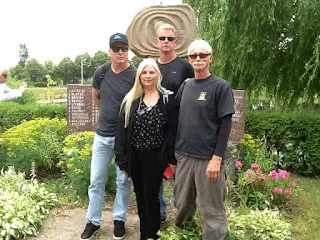J and L have recently invited certain explorers and researchers to share their stories to give a more broad appeal to those visiting
this adventurous blog. The concept of exploring and researching was the reason this venue was begun in the first place and continues to be the focus point of every writing produced.
A relative of John’s once stated: “We had a trip of
a lifetime when we went to Alaska.”
His response, as once discussed was – “Every trip is
a trip of a lifetime – not one should be dismissed over another one.”
So, in regards to this we welcome the first blog
written by our good friend and often videographer – Paul Bakas.
Home
– Lithuania Second Chance by Paul K. Bakas
 |
| Homeward bound! |
When my brother Bob suggested a summer excursion to
our native land of Lithuania, I didn't hesitate this time around. In 1992 I was offered a trip to Lithuania, but with four kids under four, it never materialized for me. With my father being born there and my mother's parents immigrating from Lithuania, it was time to go home! Bob, now on his tenth trip, I needed to make this my first trip, and I had the further joy of traveling not only with Bob but another brother Dave, my sister Marija along with my in-laws Julie, Joann, Barry and my wonderful niece Courtney.
 |
| Paul (on the right) and the rest of the Bakas Team |
As I left my wife Erin behind as she needed to attend to her aging parents the eight of us boarded a Lufthansa Airliner and headed for Germany and then the flight to Lithuania.
Of course, flying across the United States from LAX to Germany and then to our final stop in Lithuania didn't feel like a short flight but together we laughed and shared some fond memories thirty plus thousand feet above the earth.
One of the major attractions that has eluded me was a place called the Hill of Crosses which is just north of the city of Siauliai. Seeing pictures and hearing stories about this remarkable place made it a must see on my long lists of must sees.
It was where the people of a dominated country stood
up and told the dominating country to go to hell.
And they did it with crosses!
 |
| A lot of sadness but solid Lithuanian pride |
In the late 18th century Lithuania became
a vassal state of the Russian Empire which did not sit well with the citizens
and they protested loudly and regularly but carefully because back then a rebel
was stabbed or shot and buried secretly if at all. So between roughly 1830 and 1860 crosses were erected near Siauliai for those soldiers (rebels)
whose graves could not be found. The locals would place crosses on the hill in
honor of those killed during the years of the rebellion.
This tradition continued through the decades against often tyrannical and brutal governments but got particular attention during the
Soviet Union occupation when the dominating force would bulldoze down the hill
of crosses in defiance of the citizens of Lithuania.
Remember – Christian symbols are not liked by
communist societies but symbols of rebellion against overzealous authoritative
regimes really go against what the communists believe in.
The Socialist agenda – “We’re all alike unless you
disagree with the power in control!”
Anyway, politics aside I wanted to see the Hill of
Crosses for myself and to understand the magnitude of what the local people of not
only Siauliai but all of Lithuania did in rebellion against the Soviet Union.
Three times from 1963 to 1972 the Soviets actually
bulldozed the hill removing all signs of the crosses but what happened next –
you got it – the people put up more and more in honor of those Lithuanians who
gave their lives for an independent nation.
 |
| People around the world visit this memorial to human sacrifice |
The Soviets stopped and in 1993 Pope John Paul II
visited this Holy Site and declared it a piece of land that represents peace,
love and sacrifice.
 |
| Pope Paul praying for peace on the Hill of Crosses - 1993 |
So, I finally made it home to where my family roots are firmly planted and I saw one historical treasure in a country full of them with my family.
What a great experience and I will always be in debt to my brother Bob
who started this whole idea of a family reunion in Lithuania.
 |
| Paul and his brother Bob Bakas at the Hill of Crosses |
There are more stories to tell and I am sure J and L
will have no problem if I start typing again.










